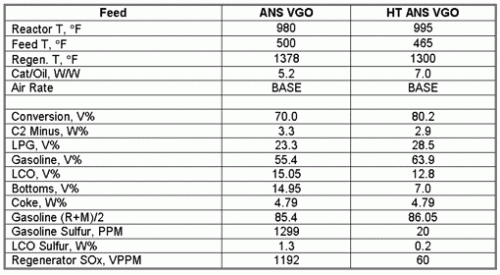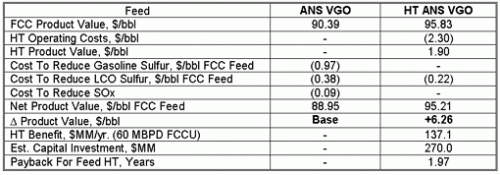How FCC Feed Hydrotreating Affects FCC Yields And Economics
The following paragraphs show an example of the effects of hydrotreating ANS VGO on a typical FCC operation. The focus of the discussion is to compare FCC feed hydrotreating with FCC product treating as competing options for making low sulfur gasoline and diesel fuels.
Table 1 presents the properties of virgin ANS VGO and compares them with the properties of the VGO after severe hydrotreating (95% desulfurization). Hydrotreating increases the API gravity of the VGO by about 5.5 numbers, increases the aniline point by 10°F, lowers the nitrogen level by about 50% and lowers the VABP by 24°F. The VABP reduction is the result of a small amount of hydrocracking that occurs in the hydrotreater.
Table 1: Impact Of Hydrotreating on ANS VGO Properties

Table 2 summarizes the effects of hydrotreating the feed on the FCC operation. The FCC unit was air rate limited. The results show that FCC feed hydrotreating increases conversion by over 10 volume percent while decreasing the yield of dry gas and substantially lowering delta coke. Because of the improvement in delta coke, the riser temperature could be increased and the feed temperature could be decreased slightly without increasing the coke yield or the air rate. These adjustments helped to increase the gasoline octane (R+M)/2 by 0.65 numbers versus the base case. The FCC gasoline sulfur was reduced to 20 ppm so that it could be successfully blended directly into a gasoline pool that requires a maximum of 30 ppm sulfur.
TABLE 2: Hydrotreating Effects on FCC Performance with ANS VGO

Since the LCO sulfur from the hydrotreated feed operation is substantially lower than the base case LCO sulfur, the cost of making ultra low sulfur diesel will be lower. Also, FCC feed hydrotreating greatly reduces the level of SOx from the FCC regenerator, eliminating the need for the use of SOx reduction agents or the operation of a flue gas scrubber.
With all of the advantages for FCC feed hydrotreating, it might appear obvious that this would be the best choice to make low sulfur products. However, due to the lower capital cost of product treating, many refiners have chosen this option. Nevertheless, current economics have made FCC feed hydrotreating more attractive relative to product treating. This is shown in Table 3, which compares a product treating case with FCC feed hydrotreating for ANS VGO. Using the yields from Table 2, the feed treating case shows a $5.44/bbl advantage in FCC product value.
TABLE 3: Economics of Hydrotreating ANS VGO

BPD moderate pressure FCC feed hydrotreater, would be about $270 MM, leading to a payback period of about 1.97 years. The conclusion is that, in the long run, refiners will profit from installing FCC feed hydrotreaters. For refiners who have not already been required to install product treaters and flue gas scrubbers (for SOx reduction), the relative attractiveness of feed hydrotreating is even greater. For more discussion on these and other related topics, the reader may be interested in the following upcoming technical seminars from Refining Process Services:
Fluid Catalytic Cracking Process Technology Sept. 17, 18, 19
FCC Unit Troubleshooting Sept. 20, 21
Hydrotreating & Hydrocracking Process Technology Oct. 3, 4, 5
These programs (along with 11 others on various refining topics) will be offered at the Crowne Plaza Houston North Greenspoint Hotel. More information is available at www.petroleumrefining.com.
Posted By: Robert J. Campagna, Refining Process Services, Inc.
